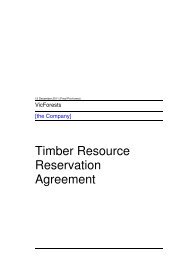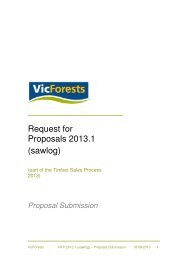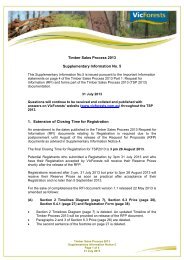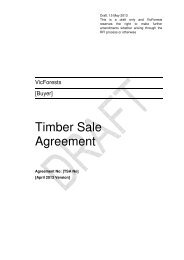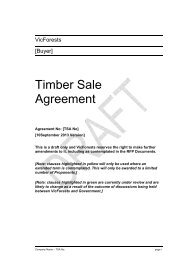Module 5 - VicForests
Module 5 - VicForests
Module 5 - VicForests
Create successful ePaper yourself
Turn your PDF publications into a flip-book with our unique Google optimized e-Paper software.
<strong>Module</strong> 5 - Harvesting and Closure<br />
Appendix I<br />
Auditee responses to matters of fact<br />
I<br />
<strong>VicForests</strong> Comments on the Draft Forest Audit Program Report 25/02/11<br />
Comment Page Coupe General Comments Auditors consideration<br />
Ref<br />
1 13 n/a The level of compliance graph illustrates that our lowest level of<br />
compliance is biodiversity conservation. This is largely due to<br />
document control and not value protection as the term<br />
biodiversity conservation implies. Can the graph be altered to<br />
A new EIA category of "No impact" has been added to the EIA tool for those issues<br />
where there it is assessed that there is no actual environmental impact as a result of a<br />
non-compliance, to distinguish them from non-compliances that result in a negligible<br />
actual or potential environmental impact.<br />
reflect what the findings were, such as weed survey<br />
documentation, machine wash down documentation etc<br />
2 13 n/a This section focuses on crossing the tape line even though the<br />
buffers were marked wider than the minimum prescribed width<br />
and the minimum with is in no way compromised The operation<br />
has therefore not impacted on the buffer. The audit has focused<br />
on the input rather than the outcome of this issue. The objective<br />
of the Environmental Assessment tool is to assess<br />
environmental impact and in this case there has been none. This<br />
'depth' of audit goes beyond the scope of the audit against the<br />
Code and Management Procedures for this element.<br />
Coupe reconnaissance and marking cause 19% of <strong>VicForests</strong><br />
OH&S incidents and 30% of our lost time injuries. The focus on<br />
the marked or taped boundary line as being sacrosanct<br />
exacerbates this potential for injury when we need to look for<br />
other, safer ways of establishing the correct boundary.<br />
In accordance with the FAP methodology, non-compliances are not limited to those<br />
areas where environmental impact is noted, but where a Code, MP or salvage<br />
prescription requirement is assessed as not having been met. The Auditor considers<br />
that there must be no ambiguity about the way that coupe boundaries are managed in<br />
terms of which tape lines can be crossed and which can not. Assessment of breached<br />
taped boundaries as non-compliances is consistent with the way that assessments have<br />
been made in past EPA audits that have been limited to Code compliance. However,<br />
the Auditor accepts that crossing of taped boundaries is technically not a noncompliance<br />
with Code or Management Procedure requirements if the required buffer<br />
remains intact. Therefore, this non-compliance has been removed and text added that<br />
the Auditor considers the culture and practice of accepting that taped boundaries may<br />
be crossed carries a risk of leading to a non-compliance.<br />
3 15 n/a Table 4.1 of total non-compliances shows no comparison to the<br />
total number of audit elements or total compliance. It also does<br />
not identify that the results are for 25 <strong>VicForests</strong> coupes and<br />
only 2 DSE coupes. Please add further context and information<br />
to this table.<br />
4 17&1<br />
8<br />
n/a<br />
At the bottom of page 17 it states that there may be a weakness<br />
in planning or mapping processes, although the top of page 18 it<br />
states that all 27 coupes were assessed as complying with the<br />
requirements pertaining to planning. How is it that there is a<br />
weakness if planning requirements comply Can this comment<br />
be removed or amended to resolve the inconsistencies<br />
especially as there is again no environmental impact.<br />
The number of compliances and total number of coupes for each of <strong>VicForests</strong> and DSE<br />
have been added.<br />
Sentence about weakness in planning remains. Further clarification that the 'Exclusion<br />
Zones' requirements address protection of exclusion zones has been added.<br />
5 21 n/a If there has been no environmental impact why has incorrect<br />
tape colour resulted in a non-compliance We do not believe this<br />
is a non-compliance as the buffers meet the requirement of the<br />
Code and Management Procedures.<br />
6 21 n/a Harvest debris was pushed over the taped boundaries but they<br />
were marked wider than the prescribed width. Therefore there<br />
was no impact on the buffer or the value being protected. We do<br />
not believe this is a non-compliance and goes beyond the scope<br />
of the audit against the Code and Management Procedures.<br />
7 21 n/a One buffer was taped at an insufficient width, but there was no<br />
harvesting activities in the area between the taped boundary and<br />
where the boundary should have been marked. Therefore there<br />
has been no environmental impact to the buffer and this goes<br />
beyond the scope of the audit against the Code and<br />
Management Procedures<br />
8 28 n/a The report states that there was no documentary evidence of soil<br />
having been removed from machinery before floating to or from<br />
a fire salvage coupe. In the Coupe Monitoring Records there is<br />
evidence of machine wash down. If more evidence is preferred,<br />
should this be a recommendation for improvement instead of a<br />
non-compliance<br />
9 43 n/a Can the dot point "trees pulled out of buffer without<br />
documentation" be worded better as it sounds like harvesting<br />
occurred in the buffer Trees were felled within the coupe but<br />
slid down a hill into a buffer. The contractor removed the trees<br />
but there was not sufficient documentation on the incident<br />
10 25 n/a If there is evidence of weeds prior to harvesting in our records<br />
we do not believe we should be issued a non-compliance for<br />
weeds located within the coupe post harvest<br />
11 26 n/a The default field for marking habitat trees states that the<br />
variation for marking should be viewed. Foresters can update<br />
this field with comments. The coupes listed below have<br />
comments in this field detailing what the marking methods were<br />
and where the habitat trees are located. If this has been<br />
identified in the coupe plan and the correct number of trees have<br />
been retained and protected the we do not believe this is noncompliant<br />
The Code requires that "the location of buffer and filter strips must be easily<br />
distinguishable in the field" and be identified in the Forest Coupe Plan. The FCP states<br />
that the buffers are marked with red tape, however they were marked in orange tape.<br />
The Auditor considers that there must be no ambiguity in relation to harvest boundaries.<br />
In accordance with the FAP methodology, non-compliances are not limited to those<br />
areas where environmental impact is noted, but where a Code, MP or salvage<br />
prescription requirement is assessed as not having been met. In this instance, the<br />
introduction of a new EIA category of "No impact" will enable the actual environmental<br />
impact (none) to be reflected.<br />
See response to comment #2.<br />
Text has been changed accordingly.<br />
See response to comment #2.<br />
Text has been changed accordingly.<br />
Where further information has been provided to the Auditor (CMRs) the audit finding has<br />
been reassessed and in all but one instance the non-compliance has been reversed,<br />
noting however that this is based on limited information. Text also added at end of<br />
paparagraph 'The Auditor notes that this presents an opportunity for improvement in the<br />
documentation of machinery wash-down activities'. See the coupe specific comments<br />
for results.<br />
Text has been changed to: "Inadequate evidence that authorisation was given to<br />
remove trees felled into buffers"<br />
All non-compliances related to weed management during harvest operations and preand<br />
post-harvest weed surveys were reassessed based on further information and<br />
comments on MOF provided by audittees:<br />
1. Where information on occurrence of weeds before harvest has been provided in the<br />
FCP or MIR, no non-compliance for pre-harvest weed surveys has been recorded,<br />
noting that at times this was based on limited information;<br />
2. Where a weed species is identified in the pre-harvest surveys and was observed by<br />
the Auditor on the coupe, a non-compliance has been recorded for the lack of evidence<br />
of management during harvest operations and the lack of post-harvest weed<br />
inspections; and<br />
3. Where a weed species is not identified in the pre-harvest surveys and was observed<br />
by the Auditor on the coupe, a non-compliance has not been recorded for the lack of<br />
evidence of management during harvest operations but a non-compliance has been<br />
recorded for the lack of post-harvest weed inspections.<br />
The report text has been updated<br />
Where further information has been provided to the Auditor (Contractor directions) the<br />
audit finding has been reassessed and in all but one instance the non-compliance has<br />
been reversed. See the coupe specific comments for results. Identified as an area for<br />
improvement.<br />
42807504/01/01




